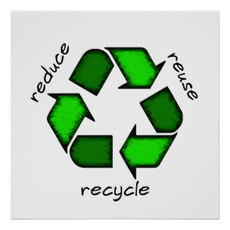
Reduce, Reuse, Recycle
LessIsMore.org works best in modern browsers like Firefox, Safari, Chrome, or Internet Explorer 8. All are free to download and will greatly improve your internet experience. Timeless wisdom when it comes to waste issues.
The absolutely best way to stop trash is to stop buying and using products that are not durable, reusable, or repairable. Reducing waste is easy if you follow some of the tips below. You'll also find lots of great info on our Reuse Tips Page.
If you know of other ways to reduce waste, please send your suggestions to us and we'll add them to the website.
We can also reduce our environmental impact and the waste we create by making sustainable purchases. Buying durable products, choosing items made from recycled materials, and thinking about the environmental impact of how our belongings are made, are all ways we can reduce out impact. To help everyone make better purchases, we made this handy dandy guide, which can be viewed here.
Reduce Your Packaging Purchases
Avoiding products wrapped in plastic or excessively packaged in boxes and bags is a great way to generate less waste. You'll also save energy and natural resources.
- Avoid packaging when possible. For example, use your own reusable bag or container.
- Use products you already have for household chores. Avoid single-use cleaning products.
- Buy large economy-sized products instead of individually wrapped items. Laundry soap, shampoo, dish-washing detergent, dry pet food, cat litter, and other non-perishable items are great examples. For food, buy the largest size you can use before spoiling.
- Buy items in bulk, in concentrate, or in refillable packages. Bulk candy, for instance, will have much less wrapping than a bag of "Fun Size" candy bars. Mmm... reducing waste...
Reduce Toxicity
Whenever possible use nonhazardous or less hazardous materials at home and work. Instead of pesticides, for example, use Integrated Pest Management (IPM) techniques to control insects and other pests. Other safety tips include:
- If you do use hazardous materials, use only what you need. Share leftovers with neighbors or donate them to businesses or charities that need them.
- Read product labels and follow all directions carefully.
If you have hazardous materials, such as motor oil, be sure to dispose of them properly. Visit our hazardous waste section for more information.
Reuse Bags, Containers, and Other Items
- Bring your reusable shopping bag to the grocery store and beyond. If you do have single-use bags, use them again!
- Bring a reusable mug to the coffee shop.
- Bring reusable take-out containers with you to restaurants (it saves them money!).
- Pack lunches in a reusable bag with reusable food and drink containers.
- Reuse containers and other materials for storage and crafts.
- Reuse single-sided printed pages for scratch paper.
- Find new homes for clothing and linens, or use them for rags, patchwork, and other projects.
Borrow, Rent, and Share!
Many of us have tools and other items that we don't use on a regular basis. Consider sharing them with your neighbors and friends. Renting is also a great option. Good candidates include:
- Power tools, ladders, garden tillers
- Boats and other outdoor equipment
- Formal wear
- Party decorations and supplies (tables etc.)
- Audiovisual equipment
Where to go
-
Outside Santa Barbara County (3)
- Earth911.com – Information Only — 3481 Plano Parkway
- Freecycle — P.O. Box 294
- Mesh — 1436 2nd Street, #330
Related Materials
- Propane Tank Reuse
- Zero Waste Events
- Stop Junk Mail
- Reduce Electronic Waste
- Portable Electronics Reuse
- Reuse Tips
- Computer Repair
- Electronics Reuse
- ReSource Center and Tajiguas Landfill Tours
- Virtual Waste Reduction Library
- Gas Powered Equipment
Related Articles
-
Keep Your Waste in Check This Holiday Season
December 21, 2018 by Leslie Robinson - Reduce & Reuse -
“Less Is More” Guide Hot Off the Press
January 18, 2023 by Kaitlyn Haberlin - Recycle, Reduce & Reuse -
America Recycles Day November 15th
November 08, 2019 by Leslie Robinson - Recycle -
New Tajiguas Resource Recovery Project Video
June 19, 2018 by Carlyle Johnston - ReSource Center -
Planning Commission to Review Design Changes for Tajiguas Resource Recovery Project
August 22, 2017 by Carlyle Johnston - ReSource Center -
Green Business Program Recruiting New Applicants
July 24, 2017 by Alan Nakashima - Recycle, Reduce & Reuse -
Put a Stop to Unwanted Phone Books
May 22, 2017 by Leslie Robinson - Reduce & Reuse -
Creating a New Generation of Environmental Stewards
May 31, 2015 by Sam Dickinson - Recycle, Reduce & Reuse -
New Options for Recycling Old Textiles
January 01, 2020 by Tom Chiarodit - Recycle, Reduce & Reuse -
FREE Deconstruction and Reuse Classes at SBCC
July 13, 2020 by Kaitlyn Haberlin -
New Food Forward Booklet!
July 30, 2023 by Kaitlyn Haberlin - Organics -
2019/2020 Resource Recovery Waste Management Annual Report Now Available!
January 11, 2021 by Tori Kampmann -
New Year, New Protocol!
February 02, 2022 by Tori Kampmann -
Hazardous Waste Center Closed for Easter Holiday
March 25, 2024 by Kaitlyn Haberlin